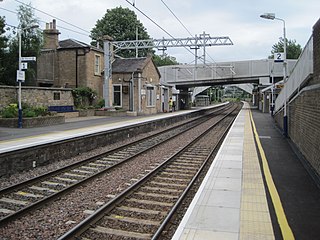Related Research Articles

Robert Stevenson Horne, 1st Viscount Horne of Slamannan, was a Scottish businessman, advocate and Unionist politician. He served under David Lloyd George as Minister of Labour between 1919 and 1920, as President of the Board of Trade between 1920 and 1921 and as Chancellor of the Exchequer between 1921 and 1922. In 1937 he was ennobled as Viscount Horne of Slamannan.
The Edinburgh and Glasgow Railway was authorised by Act of Parliament on 4 July 1838. It was opened to passenger traffic on 21 February 1842, between its Glasgow Queen Street railway station and Haymarket railway station in Edinburgh. Construction cost £1,200,000 for 46 miles (74 km). The intermediate stations were at Corstorphine, Gogar, Ratho, Winchburgh, Linlithgow, Polmont, Falkirk, Castlecary, Croy, Kirkintilloch and Bishopbriggs. There was a ticket platform at Cowlairs. The line was extended eastwards from Haymarket to North Bridge in 1846, and a joint station for connection with the North British Railway was opened on what is now Edinburgh Waverley railway station in 1847.
The Edinburgh–Bathgate line is a railway line in East Central Scotland. It is also known as the Bathgate branch and was originally operated by the Edinburgh and Bathgate Railway. Except for the short section at the original Bathgate terminus, the main line is still in use, with a frequent passenger train service operated by ScotRail.

Polmont railway station is a railway station serving the village of Polmont, Scotland as well as the other Falkirk Braes villages. It is located on the Glasgow to Edinburgh via Falkirk Line and is also served by ScotRail services from Edinburgh to Stirling and Dunblane. It is the nearest station to much of the town of Grangemouth.
The Scottish Central Railway was formed in 1845 to link Perth and Stirling to Central Scotland, by building a railway line to join the Edinburgh and Glasgow Railway near Castlecary.

The Aberdeen Railway was a Scottish railway company which built a line from Aberdeen to Forfar and Arbroath, partly by leasing and upgrading an existing railway.
The Ballochney Railway was an early railway built near Airdrie, Lanarkshire, now in Monklands, Scotland. It was intended primarily to carry minerals from coal and ironstone pits, and stone quarries, in the area immediately north and east of Airdrie, to market, predominantly over the adjoining Monkland and Kirkintilloch Railway. Passengers were carried later.
The Slamannan Railway was an early mineral railway between the north-eastern margin of Airdrie and Causewayend on the Union Canal, near Linlithgow, Scotland.
The Monkland and Kirkintilloch Railway was an early mineral railway running from a colliery at Monklands to the Forth and Clyde Canal at Kirkintilloch, Scotland. It was the first railway to use a rail ferry, the first public railway in Scotland, and the first in Scotland to use locomotive power successfully, and it was a major influence in the successful development of the Lanarkshire iron industry. It opened in 1826.
The Monkland Railways was a railway company formed in 1848 by the merger of three "coal railways" that had been built to serve coal and iron pits around Airdrie in Central Scotland, and connect them to canals for onward transport of the minerals. The newly formed company had a network stretching from Kirkintilloch to Causewayend, near Linlithgow. These coal railways had had mixed fortunes; the discovery of blackband ironstone and the development of the iron smelting industry around Coatbridge had led to phenomenal success, but hoped-for mineral discoveries in the moorland around Slamannan had been disappointing. The pioneering nature of the railways left them with a legacy of obsolete track and locomotives, and new, more modern, railways were being built around them.
The Slamannan and Borrowstounness Railway was a railway built in Scotland in 1848 to extend the Slamannan Railway to the harbour at Borrowstounness on the Firth of Forth, and to connect with the Edinburgh and Glasgow Railway. It was not commercially successful, but in recent years part of it was taken over by the Scottish Railway Preservation Society, which operates the Bo'ness and Kinneil Railway.
Arbuckle railway station served the village of Arbuckle in the Scottish county of North Lanarkshire. The station was the meeting point of two early railway companies.
Avonbridge railway station was a station on the Slamannan Railway. The line connected mines and villages in the Central Scotland.
Arden railway station was a station on the Slamannan Railway. The line connected mines and villages in the Central Scotland.

Weaste railway station is a closed station on the Liverpool to Manchester line located between Seedley and Eccles in Salford.
Longriggend railway station was a railway station serving the village of Longriggend, North Lanarkshire, Scotland. The station was part of the Slamannan Railway which amalgamated with several other local railways to form the Monkland Railways.

Bowhouse railway station served the suburb of Bowhouse, Falkirk, Scotland, from the 1840s to 1964 on the Slamannan Railway.
Slamannan railway station served the village of Slamannan, Falkirk, Scotland, from 1840 to 1930 on the Slamannan Railway.
Whiterigg railway station served the village of Maddiston, North Lanarkshire, Scotland, from 1862 to 1930 on the Slamannan Railway.